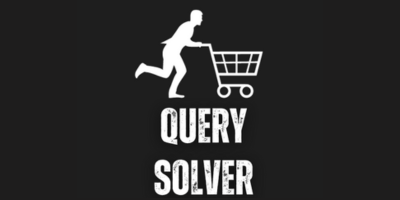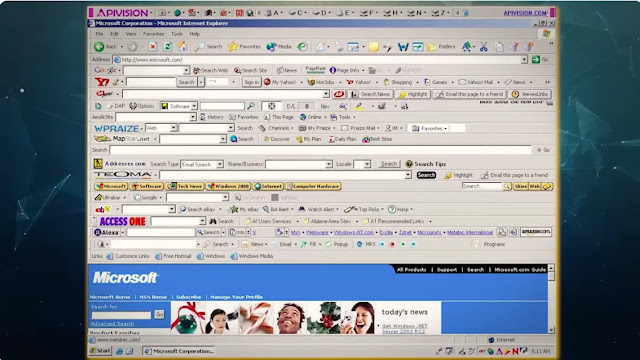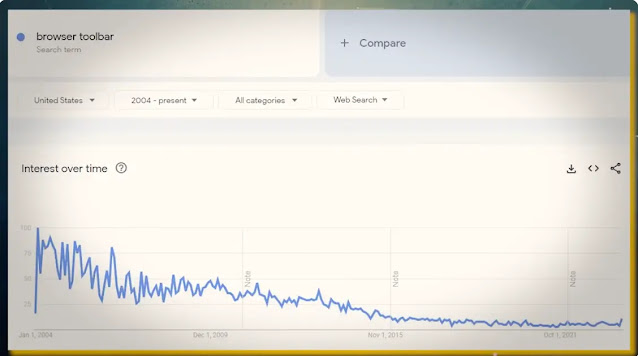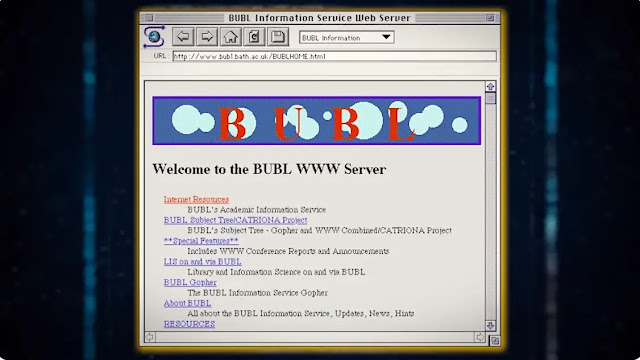TOOLBARS
Remember toolbars? Back in the late 90s and early 2000s, toolbars were basically synonymous with the address bar of Internet Explorer. You had toolbars for searching, toolbars for shortcuts, toolbars for torrents, and of course, toolbars that you accidentally installed as bloatware. And some people’s browsers no joke looked just like this.
But, that’s not too surprising given that basically every major tech company had its own set of toolbars from MSN messenger and Yahoo to AOL and ask.com, and they all seemed somewhat useful. But likely the most recognizable toolbar of all time is none other than the Google Toolbar. In fact, I would argue that the Google toolbar was one of the main products that initially put Google on the map.
If you’re on the younger side, you may have never seen the internet before Chrome, but the truth is that Chrome was actually a rather late entry into the browser space having not come out till late 2008. Up until this point, the only way to easily access Google was to either install the toolbar or type in google.com into the address bar, something that I would hope that we all know is a sin.
So, most people resorted to the former. Fun fact, Sundar Pichai’s first job at Google was actually to lead product management for the Google Toolbar back in 2004. But since then, toolbars have largely fallen out of favor. To be honest, I can’t remember the last time I saw someone with even a single toolbar.
And taking a look at Google trends, this seems to be the overarching trend. Browser toolbars have been on a downward spiral for nearly 20 years now. In fact, Google themselves killed off its toolbar at the end of 2021, so it seems that the era of browser toolbars is very much over, but why?
It seems that having quick access to the most popular services that you use right underneath the address bar would be rather convenient. Well, it turns out the answer actually has a lot more to do with maximizing control, power, and influence over the web as opposed to some sort of logical reason. So, join me, as we take a look back at what really happened to toolbars.
Also Read: Why AI Will Never Replace Our Jobs
TOOLBARS MAKE THEIR DEBUT
Taking a look back, the story of toolbars dates back to the early 1990s well before the internet or browsers were mainstream. Toolbars, which were originally called ribbons, were actually largely popularized by Microsoft who introduced them into the Office suite. These ribbons were almost immediately a hit as they made the software far more useful and accessible.
As you know, these ribbons are still around to this day and are very much a critical part of any Office product. But, while Office ribbons took off quite early on, it took a lot longer for browser toolbars to even make their debut, largely because browsers weren’t really even a thing yet. Of course, you had the WorldWideWeb browser that came out in 1990, but it wasn’t until Mosaic and more notably Netscape that browsers really started gaining mainstream popularity.
This trend was simply put into overdrive in 1995 when Microsoft launched Internet Explorer and started bundling it with Windows. But, while browsers were really starting to gain momentum, they were still quite rudimentary.
Here’s how Mosaic looked for example. It could only display static content and functionality was largely limited by what the browser developers were able to pack. As such, it was only a matter of time until we saw the world of browser extensibility begin to evolve starting with plug-ins. This of course starts with the infamous Adobe Flash Player in 1996 and Java in 1998.
These two revolutionized the browsing experience as they opened the door for everything from dynamic websites and video streaming to browser games and more intense enterprise applications. And as people started getting used to more capable browsers, they naturally wanted to do more and more leading us into the era of browser toolbars.
In the late 90s and early 2000s, we saw the first 3rd party toolbars pop up but unlike the Office ribbons, these didn’t exactly blow up in popularity. In fact, it was quite the opposite until a special someone stepped into the field: Google. Despite eventually becoming the world’s largest internet company, Google didn’t start off with grand ambitions.
In fact, it wasn’t even originally called Google, it was actually called Backrub. And Backrub started off as an academic research project that was more focused on the theoretical side of how to organize and rank so much data. Fortunately, the name Backrub didn’t stick around for long but Google stayed an academic project.
In fact, it was actually originally launched on Stanford’s network with the domain google.stanford.edu in 1996. And it wasn’t till 2 years later that Google was turned into a company but even this wasn’t too serious. The founders were actually willing to sell all of Google for just $1 million in 1999 but the buyers passed on the deal.
But after this deal fell through, everything changed. Google was no longer just a college project with a generous exit. It was a serious company that needed to maximize users and revenue but the reality was that Google was competing in a rather saturated space.
All of the biggest companies including AOL, Microsoft, and Yahoo wanted to control the search space. And sure, Google might’ve had higher-quality search results but this only mattered people even tried it. What Google needed was a new way to put their search engine in front of people: enter the Google toolbar.
Also Read: Why People Are Switching From Android to iOS
TOOLBARS TAKEOVER
The Google toolbar made its debut on Toolbars Takeover on December 11, 2000, with one simple goal: make high-quality search results easier to access than ever. At first, the toolbar was basically just a search bar that allowed you to easily search Google from any website, but over the years, the toolbar became much more than just that.
For example, after the launch of Gmail, users could link the toolbar with their email and load saved bookmarks and history. Google also introduced features such as translation, autofill, and spell-checking into the toolbar. All of these features made the Google toolbar quite useful but its usefulness itself wasn’t what drove its popularity.
One of the main ways that Google made its toolbar popular was by making it bloatware. I’m not even kidding, Google partnered with a bunch of already popular software companies and stuck deals to bundle in the toolbar with their software. For example, they had had such deals with RealPlayer and even Sun Microsystems.
Anyway, as the Google toolbar started to gain popularity, the big boys naturally stepped into the arena as well. In 2004, Microsoft launched an MSN toolbar, AOL launched a toolbar, and Yahoo even launched a toolbar for Firefox. And all of these were quite popular. In fact, toolbars accounted for 12% of search queries at Google, 18% at Yahoo, and a whopping 42% at Ask. And that’s just the search queries that were directly being made through these toolbars.
Who knows how many people these toolbars actually drove to each of these services. It wasn’t just these giants that were launching toolbars though. Every internet company you could think of suddenly had a toolbar. The one that stuck out to me the most was from Amazon actually.
Before Alexa became the voice of Amazon, Amazon actually had a toolbar called Alexa but as you would guess, not all toolbars were quite as benign or as helpful as Alexa which leads us to likely the biggest pitfall of toolbars: their perception. Throughout the 2000s, toolbars quickly built up an association with malware, spyware, and bloatware.
Many of the toolbars that you ended up with weren’t even intentional. You were just trying to download Winrar or uTorrent, and all of a sudden, the next time you open up your browser, you’re met with this horrendous blob at the top.
Ironically, Google was very much part of the problem but they weren’t too concerned about that because they were starting to sense a much bigger problem. You see, Google was starting to become a bit too successful. In 2004, they would IPO, and just 1 year later, they would reach a market cap of $100 billion, and this success started to make the big players rather nervous.
Google was no longer the scrappy startup with the popular search engine and toolbar. They had a full slew of products including YouTube, Gmail, and Android, and with a market cap of $100 billion, they were very much a big tech company that was eating into the market shares of Hotmail, Yahoo, and MSN. And the worst part about all of this was that Microsoft was that they were not just standing by and watching it happen, they were literally enabling it.
After all, it was Internet Explorer’s generous toolbar compatibility that had made the Google Toolbar so popular in the first place. As such, it was time for Microsoft to put its own products first and block out leeches like Google, and with that, they did absolutely nothing. The reality is that while it was likely that Microsoft felt somewhat threatened by Google’s rising dominance, they never actually did anything about it. Google, on the other hand, did.
Also Read: Story of Twilio and how Jeff Lawson Made $72 Billion Sending OTPs
GOOGLE PUTS DOWN TOOLBARS
In 2006, Sundar Pichai, the leader of Google toolbar development, made the bold claim that Microsoft could change Internet Explorer at any time to threaten Google’s toolbar business. His solution to this concern was for Google to create its own browser and challenge Microsoft before Microsoft pulled the rug.
Was he actually concerned about Microsoft pulling the rug or did he just use this fear as a way to sell Chrome? To be honest, it was probably more of the latter. You see, Sundar had already pitched the idea of Chrome before but his idea was rejected due to cost concerns. So, it seems that Sundar cleverly used the Microsoft threat to frame Chrome as a defensive move as opposed to an offensive move, and it worked.
Chrome would be green-lit and Sundar would be placed at the helm, and 2 years later, we would see the launch of Chrome on September 2, 2008. From the very beginning, the intention of Chrome was pretty clear: cut out competitors and grow power for Google, but to their credit, they did frame this really well.
Instead of saying that Chrome wouldn’t support any toolbars, they pitched Chrome as a super clean browser that wasn’t bogged down by a bunch of extensions. Now, I do want to note that Chrome didn’t support their own toolbar itself but this isn’t really a sacrifice. After all, with Chrome, Google had control over the entire browser.
Despite this clear ulterior motive though, most people didn’t really care. They were fed up with toolbars being bloatware and Internet Explorer in general. So, when Google came out with a clean browser, it didn’t take long for people to switch over and for Chrome to become the dominant browser.
Chrome did eventually come out with their own store for 3rd party extensions called the Chrome Webstore but they made sure to differentiate it from toolbars such that no extension would really be a threat to Google search. And that was really the end of it.
With Chrome dropping support for traditional toolbars and Chrome becoming the dominant browser, toolbars quickly became a relic of the past. If anything, most users were happy to move away from toolbars as they very much remembered the nightmares of this.
So, toolbars went down as just something that naturally went obsolete with evolving technology. But the reality was that it wasn’t all that natural. It was Google that made toolbars popular in the first place and it was Google that eventually killed toolbars as well with the launch of Chrome, and that’s what really happened to toolbars.





